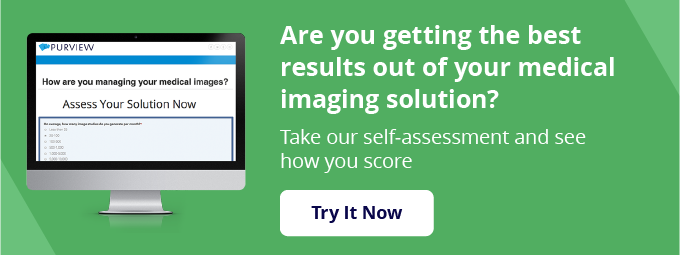For a Cloud PACS, How Fast Does My Internet Access Need to Be?

When comparing a cloud picture archiving and communication system (PACS) to a traditional onsite solution, one of the most common questions we hear is, "What effect does limited bandwidth have on my ability to use a cloud-based PACS?"
It's an understandable question. The same benefits that make a cloud-based PACS so appealing — among them, dynamic amounts of storage, data backups and easy image sharing — are all rendered moot if your internet is too slow to take advantage of them. In particular, the sometimes massive files that make up medical imaging studies may require longer amounts of time to download and upload when your bandwidth is constricted.
However, there is good news. Worries regarding low bandwidth have been greatly exaggerated. Even if you have low bandwidth at your practice, you can still rely on a cloud-based solution.
Techniques for Leveraging Cloud PACS with Low Bandwidth
If your bandwidth is at least 10 megabits (Mbps) for both uploading and downloading, then you should have no problem operating a cloud-based PACS in your environment. Anything over this threshold should be more than sufficient. While speeds greater than 10 Mbps are ideal, even practices with internet connections as low as 1 Mbps are likely able to take advantage of cloud PACS services.
For instance, if you were to work with Purview, you would be able to test your download and upload speeds with our data center specifically by clicking on the button below:
If your bandwidth is low, there are two strategies you can employ to make sure that you can get the most out of your cloud solution. They include:
- Lossless compression
- Buffering the use of your internet's bandwidth
Shrinking files using lossless compression means that you don't lose any information, even though the compressed files can be up to 10 times smaller than the original. It's a simple and painless process and often is done automatically by your cloud PACS. Lossless compression is not to be confused, however, with "lossy" compression, which does result in lost information and is, therefore, unsuitable for most medical images.
In addition or as an alternative, you can use a "mediator" that buffers the use of the bandwidth at your practice and ensures that your images are sent when your bandwidth is most available. Rather than timing out when you attempt to upload a large file, a buffer can maintain the connection until there is sufficient bandwidth to transfer all or part of the file.
The use of buffers for bandwidth management means that even with a slow connection, your files can still get transferred — usually at times when you are not around so you won't have to personally attend to it. You can still use the cloud and get all of the related benefits and all the flexibility. This too is simple to accomplish with some smart software on the sending side.
When uploading medical imaging studies, this buffer typically makes use of a cache where images that were recently scanned are stored and made available locally before they're sent to the cloud. Most any desktop computer has the ability to cache a file to enable it to be buffered with a slow internet connection.
In this way, studies can be "dripped" to the cloud, or sent while they're still maintained locally. This means you still have local access to the images immediately even while they are waiting to be sent to the cloud.
Yes, It Is Possible
Among others, urgent care facilities, imaging centers and specialist doctors, such as neurosurgeons and oncologists, all need to share images with other physicians — sometimes as quickly as possible in order to provide the best care for a patient. Unfortunately, these physicians often worry that their internet speeds aren't lightning-fast, which means that they'll be unable to install and leverage the benefits of a cloud-based PACS.
By following the simple recommendations outlined above, concerns about low bandwidth are almost always unfounded. Relying on the trifecta of careful bandwidth management, compression and buffering makes it much more likely that you will be able to achieve a sufficient internet connection for use with a cloud PACS from almost anywhere. That said, the opportunity to install high speed bandwidth may provide additional benefits in the form of speed and usability with your system.
So, while it is possible to leverage a cloud PACS with very low internet bandwidth, it's up to you to determine what level of upload and download speed you're comfortable paying for when weighed against the incremental value faster speeds provide.



